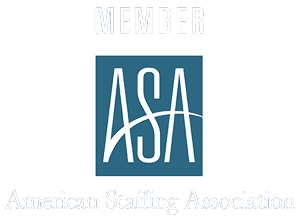Whether intentional or not, misclassifying workers isn’t just a paperwork mistake. It’s a serious financial and legal risk for staffing firms. In 2024, the U.S. Department of Labor’s Wage and Hour Division (WHD) recovered more than $273 million in back wages and damages for nearly 152,000 workers nationwide due to classification errors.¹
For staffing firms, the stakes are even higher. A single misclassification can disrupt multiple contracts, damage client trust, and lead to costly fines or audits. These fines are quite severe that the IRS has a Voluntary Classification Settlement Program (VCSP) to help firms reclassify their workers.2
Understanding the difference between 1099 independent contractors and W-2 employees is essential for compliance. In this article, we’ll break down the key distinctions, provide a practical classification checklist, and explore how partnering with a back-office provider can help staffing firms avoid costly mistakes.
Understanding 1099 vs. W-2 Classification
A 1099 independent contractor and a W-2 employee might do similar work, but they are classified differently in ways that affect taxes, benefits, and legal responsibilities.
A 1099 contractor works on their own, sets their own schedule, and handles their own taxes. They don’t receive benefits like health insurance or paid time off from the company. A W-2 employee, on the other hand, follows their employer’s schedule, has employment tax taken out of their paycheck, and qualifies for company benefits.
Getting this classification wrong can lead to serious problems like fines, audits, and back taxes. That’s why it’s important for staffing firms to understand these differences and classify workers correctly to avoid costly mistakes. Here are some differences between them:
- Control & Independence: A 1099 independent contractor works independently and sets their own schedule, while a W-2 employee follows their employer’s schedule and guidelines.
- Taxes: When it comes to taxes, a 1099 contractor is responsible for paying self-employment taxes and files a 1099 form. In contrast, a W-2 employee has income taxes withheld by their employer and files a W-2 form.
- Benefits: In terms of benefits, 1099 contractors do not receive employer-provided benefits, whereas W-2 employees may be eligible for health insurance, paid time off (PTO), and retirement plans.
- Legal: 1099 contractors are not considered employees of the company, while W-2 employees have an official employment relationship with the company or staffing firm.
How to Determine the Right Classification for Your Workers
Here are a few tests to keep in mind when deciding how to classify your workers:
IRS Common Law Test
Behavioral Control: Does the company control or have the right to control what the worker does and how they do their job? More control indicates a W-2 employee relationship.
Financial Control: Does the company dictate how the worker is paid, reimburse expenses, or provide tools and supplies? If so, the worker is likely a W-2 employee.
Type of Relationship: Are there written contracts or employee benefits like a pension plan, insurance, or vacation pay? Will the relationship continue, and is the work a key part of the business? If yes, the worker is more likely a W-2 employee.
Department of Labor’s Economic Reality Test
The Department of Labor’s Economic Reality Test helps determine whether a worker is an employee or an independent contractor based on these six factors:
Profit or Loss Opportunity: Contractors control their earnings; employees typically don’t.
Worker vs. Employer Investment: Contractors provide their own tools and resources; employees rely on the company.
Permanence of Relationship: Long-term roles suggest employment, while short-term or project-based work aligns with contracting.
Control Over Work: Employees follow company policies; contractors have more independence.
Integral Part of Business: If the work is central to the company’s success, the worker is likely an employee.
Skill & Initiative: Contractors use specialized skills and find their own clients; employees work under direction.
ABC Test (Used in Some States)
Some states use the ABC Test to determine if a worker is truly an independent contractor. To qualify, the worker must meet all three of these criteria:
Freedom from Control: The worker operates independently, without direct supervision from the company.
Different Type of Work: Their work is outside the company’s core business.
Independent Business: They have an established trade or profession separate from the company.
If a worker fails to meet any of these conditions, they are considered an employee under state law.
The Risks of Misclassification
What are the risks of misclassifying workers—and more importantly, how do they hurt your business? Let’s break down the key dangers of misclassification.
Financial and Legal Consequences
Misclassifying workers as independent contractors instead of employees can result in serious financial and legal consequences, including:
- IRS Penalties: Up to 100 percent of unpaid payroll taxes plus interest.
- Department of Labor Fines: Ranging from $2,500 to $2,500 per violation.
- State-Specific Penalties: Some states, like California and New York, have even harsher fines.
- Lawsuits & Back Pay: Employers may be required to compensate workers for unpaid overtime, benefits, and lost wages.
Industry-Specific Challenges for Staffing Firms
Staffing firms face unique risks when it comes to worker classification, including:
Multi-Client Exposure: A misclassified worker can create legal and financial liabilities for multiple clients.
Varying State Regulations: Operating across different states means navigating inconsistent classification laws, increasing compliance complexity.
Client Trust & Contracts: Misclassification issues can erode client confidence, potentially leading to lost contracts and damaged reputation.
Real-World Cases of Costly Misclassification
FedEx Ground (2015): Misclassified drivers as independent contractors, leading to a $228 million settlement. Similarly, Uber (2022), had to settle a class-action lawsuit with California drivers, costing $8.4 million.
How Partnering with a Back Office Provider Helps Prevent Misclassification
With so many risks involved in worker misclassification, you can’t afford to leave it to chance. Here’s how a back office provider like Signature Back Office helps keep your worker classification right:
Ensures Accurate Worker Classification
For many staffing firms, worker classification is a complex challenge. Misclassification can lead to costly fines, audits, and even legal disputes. Trying to navigate IRS, DOL, and state-specific rules without expert support increases the risk of errors.
A back office provider helps staffing firms classify workers correctly by:
- Evaluating worker status based on IRS, DOL, and state-specific guidelines
- Using automated tools to reduce human error and ensure compliance
- Keeping up with evolving regulations to prevent misclassification risks
The back office provider automatically classifies the candidate whenever a placement is made. Completing the New hire information form helps ensure a smooth process.
Handles Payroll and Tax Compliance
Managing payroll and tax compliance is another complex process, especially for staffing firms handling both W-2 employees and independent contractors. A back office provider takes on this responsibility, ensuring accuracy and compliance at every step.
They process payroll by correctly withholding taxes for W-2 employees while managing 1099 payments and filings for independent contractors. This includes verifying W-9s, processing 1099 forms, and keeping up with changing employment tax laws to prevent compliance issues.
By centralizing payroll and tax compliance, staffing firms can reduce errors, avoid penalties, and focus on growing their business without the administrative burden.
Provides Compliance Support and Risk Mitigation
Labor laws are always changing. Regulations vary by state and missteps can lead to costly audits, fines, or legal disputes. Keeping up with each law and regulation is neither practical nor cost-effective. A reliable back office provider makes the difference in staying compliant by monitoring federal, state, and local labor laws, to ensure your firm meets all classification and payroll requirements.
This ongoing support means you’re reducing liability, while having the confidence to scale without compliance concerns holding you back.
Offers Employer of Record (EOR) Services for Compliance
Managing worker classification, payroll, and compliance is complex and time-consuming. An Employer of Record (EOR) takes on these responsibilities, serving as the legal employer for W-2 workers and ensuring proper classification.
By handling payroll, benefits, and tax withholdings, an EOR helps staffing firms stay compliant with federal and state regulations. This reduces the risk of misclassification and legal issues while allowing staffing firms to focus on recruitment and client relationships instead of administrative burdens.
Worker classification, simplified with Signature Back Office
Navigating the complexities of worker classification, especially in different jurisdictions, requires not just awareness but also the right strategies and support to stay compliant and mitigate risk.
Signature Back Office helps staffing companies simplify classification, ensuring that every worker is properly classified. By leveraging our expert guidance, you can focus on what you do best: connecting businesses with top talent while staying protected from misclassification pitfalls.
References
- “Impact in Fiscal Year 2024.” DOL, www.dol.gov/agencies/whd/data.
- Voluntary Classification Settlement Program | Internal Revenue Service. www.irs.gov/businesses/small-businesses-self-employed/voluntary-classification-settlement-program.





